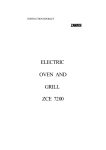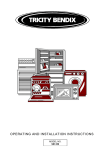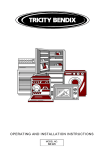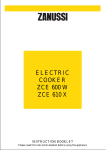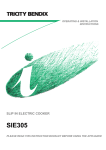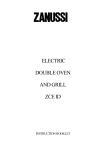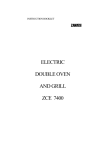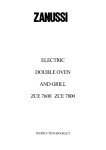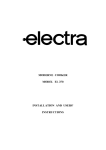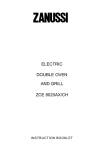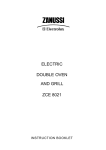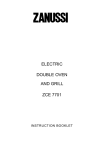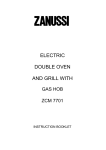Download Zanussi ZCE 7300 Instruction Booklet
Transcript
ELECTRIC OVEN AND GRILL ZCE 7300 INSTRUCTION BOOKLET TECHNICAL DETAILS MODEL NO. ZCE 7300 Voltage: 230/240 Volts AC 50 Hz Wattage: 11.9/13.0kW Height: 900mm Width: 500mm Depth: 600mm This appliance complies with: European Council Directive 73/23/EEC. EMC Directive 89/336/EEC. CE Marking Directive 93/68/EEC. 2 CONTENTS Technical Details . . . . . . . . . . . . . . . . . . . . . . . . . . . . . . . . . . . . . . . . . . . . . . . . . . . . . . . . . . . . . . . . . . . . . . . . . . . . . . . . . 2 Contents . . . . . . . . . . . . . . . . . . . . . . . . . . . . . . . . . . . . . . . . . . . . . . . . . . . . . . . . . . . . . . . . . . . . . . . . . . . . . . . . . . . . . . . . . 3 Preface . . . . . . . . . . . . . . . . . . . . . . . . . . . . . . . . . . . . . . . . . . . . . . . . . . . . . . . . . . . . . . . . . . . . . . . . . . . . . . . . . . . . . . . . . . . 5 Safety . . . . . . . . . . . . . . . . . . . . . . . . . . . . . . . . . . . . . . . . . . . . . . . . . . . . . . . . . . . . . . . . . . . . . . . . . . . . . . . . . . . . . . . . . . . . . Before Installation . . . . . . . . . . . . . . . . . . . . . . . . . . . . . . . . . . . . . . . . . . . . . . . . . . . . . . . . . . . . . . . . . . . . . . . . . . . During Operation . . . . . . . . . . . . . . . . . . . . . . . . . . . . . . . . . . . . . . . . . . . . . . . . . . . . . . . . . . . . . . . . . . . . . . . . . . . After Use . . . . . . . . . . . . . . . . . . . . . . . . . . . . . . . . . . . . . . . . . . . . . . . . . . . . . . . . . . . . . . . . . . . . . . . . . . . . . . . . . . . General . . . . . . . . . . . . . . . . . . . . . . . . . . . . . . . . . . . . . . . . . . . . . . . . . . . . . . . . . . . . . . . . . . . . . . . . . . . . . . . . . . . . 6 6 6 7 7 Introduction . . . . . . . . . . . . . . . . . . . . . . . . . . . . . . . . . . . . . . . . . . . . . . . . . . . . . . . . . . . . . . . . . . . . . . . . . . . . . . . . . . . . . . Rating Plate . . . . . . . . . . . . . . . . . . . . . . . . . . . . . . . . . . . . . . . . . . . . . . . . . . . . . . . . . . . . . . . . . . . . . . . . . . . . . . . . Installation . . . . . . . . . . . . . . . . . . . . . . . . . . . . . . . . . . . . . . . . . . . . . . . . . . . . . . . . . . . . . . . . . . . . . . . . . . . . . . . . . . Reversible Oven Door . . . . . . . . . . . . . . . . . . . . . . . . . . . . . . . . . . . . . . . . . . . . . . . . . . . . . . . . . . . . . . . . . . . . . . . General Notes on Using Your Cooker . . . . . . . . . . . . . . . . . . . . . . . . . . . . . . . . . . . . . . . . . . . . . . . . . . . . . . . . Control Panel Indicator Neon . . . . . . . . . . . . . . . . . . . . . . . . . . . . . . . . . . . . . . . . . . . . . . . . . . . . . . . . . . . . . . . . About Condensation and Steam . . . . . . . . . . . . . . . . . . . . . . . . . . . . . . . . . . . . . . . . . . . . . . . . . . . . . . . . . . . . . Grill and Oven Furniture . . . . . . . . . . . . . . . . . . . . . . . . . . . . . . . . . . . . . . . . . . . . . . . . . . . . . . . . . . . . . . . . . . . . . 8 8 8 9 9 9 9 9 Getting to know your Cooker . . . . . . . . . . . . . . . . . . . . . . . . . . . . . . . . . . . . . . . . . . . . . . . . . . . . . . . . . . . . . . . . . . . . 10 The Control Panel . . . . . . . . . . . . . . . . . . . . . . . . . . . . . . . . . . . . . . . . . . . . . . . . . . . . . . . . . . . . . . . . . . . . . . . . . 10 Electronic Minute Minder . . . . . . . . . . . . . . . . . . . . . . . . . . . . . . . . . . . . . . . . . . . . . . . . . . . . . . . . . . . . . . . . . . . . . . . . 11 The Sealed Hotplates . . . . . . . . . . . . . . . . . . . . . . . . . . . . . . . . . . . . . . . . . . . . . . . . . . . . . . . . . . . . . . . . . . . . . . . . . . . . Recommended Saucepans . . . . . . . . . . . . . . . . . . . . . . . . . . . . . . . . . . . . . . . . . . . . . . . . . . . . . . . . . . . . . . . . . Hints and Tips . . . . . . . . . . . . . . . . . . . . . . . . . . . . . . . . . . . . . . . . . . . . . . . . . . . . . . . . . . . . . . . . . . . . . . . . . . . . . Deep Fat Frying . . . . . . . . . . . . . . . . . . . . . . . . . . . . . . . . . . . . . . . . . . . . . . . . . . . . . . . . . . . . . . . . . . . . . . . . . . . Preserving . . . . . . . . . . . . . . . . . . . . . . . . . . . . . . . . . . . . . . . . . . . . . . . . . . . . . . . . . . . . . . . . . . . . . . . . . . . . . . . . . 13 13 13 14 14 The Grill . . . . . . . . . . . . . . . . . . . . . . . . . . . . . . . . . . . . . . . . . . . . . . . . . . . . . . . . . . . . . . . . . . . . . . . . . . . . . . . . . . . . . . . . Uses of the Grill . . . . . . . . . . . . . . . . . . . . . . . . . . . . . . . . . . . . . . . . . . . . . . . . . . . . . . . . . . . . . . . . . . . . . . . . . . . Selecting the Grill . . . . . . . . . . . . . . . . . . . . . . . . . . . . . . . . . . . . . . . . . . . . . . . . . . . . . . . . . . . . . . . . . . . . . . . . . . Things To Note . . . . . . . . . . . . . . . . . . . . . . . . . . . . . . . . . . . . . . . . . . . . . . . . . . . . . . . . . . . . . . . . . . . . . . . . . . . . The Grill Pan and Handle . . . . . . . . . . . . . . . . . . . . . . . . . . . . . . . . . . . . . . . . . . . . . . . . . . . . . . . . . . . . . . . . . . . Hints and Tips . . . . . . . . . . . . . . . . . . . . . . . . . . . . . . . . . . . . . . . . . . . . . . . . . . . . . . . . . . . . . . . . . . . . . . . . . . . . . Grilling Chart . . . . . . . . . . . . . . . . . . . . . . . . . . . . . . . . . . . . . . . . . . . . . . . . . . . . . . . . . . . . . . . . . . . . . . . . . . . . . . 15 15 15 15 15 16 16 The Fan Oven . . . . . . . . . . . . . . . . . . . . . . . . . . . . . . . . . . . . . . . . . . . . . . . . . . . . . . . . . . . . . . . . . . . . . . . . . . . . . . . . . . . Uses of the Fan Oven . . . . . . . . . . . . . . . . . . . . . . . . . . . . . . . . . . . . . . . . . . . . . . . . . . . . . . . . . . . . . . . . . . . . . . Selecting the Fan Oven . . . . . . . . . . . . . . . . . . . . . . . . . . . . . . . . . . . . . . . . . . . . . . . . . . . . . . . . . . . . . . . . . . . . Things To Note . . . . . . . . . . . . . . . . . . . . . . . . . . . . . . . . . . . . . . . . . . . . . . . . . . . . . . . . . . . . . . . . . . . . . . . . . . . . To Fit the Oven Shelves . . . . . . . . . . . . . . . . . . . . . . . . . . . . . . . . . . . . . . . . . . . . . . . . . . . . . . . . . . . . . . . . . . . Hints and Tips . . . . . . . . . . . . . . . . . . . . . . . . . . . . . . . . . . . . . . . . . . . . . . . . . . . . . . . . . . . . . . . . . . . . . . . . . . . . . 17 17 17 17 18 18 Oven Cooking Chart . . . . . . . . . . . . . . . . . . . . . . . . . . . . . . . . . . . . . . . . . . . . . . . . . . . . . . . . . . . . . . . . . . . . . . . . . . . . . 19 Roasting Chart . . . . . . . . . . . . . . . . . . . . . . . . . . . . . . . . . . . . . . . . . . . . . . . . . . . . . . . . . . . . . . . . . . . . . . . . . . . . . . . . . . 20 3 CONTENTS Defrosting . . . . . . . . . . . . . . . . . . . . . . . . . . . . . . . . . . . . . . . . . . . . . . . . . . . . . . . . . . . . . . . . . . . . . . . . . . . . . . . . . . . . . . . Uses of Defrost Feature . . . . . . . . . . . . . . . . . . . . . . . . . . . . . . . . . . . . . . . . . . . . . . . . . . . . . . . . . . . . . . . . . . . Selecting Defrost . . . . . . . . . . . . . . . . . . . . . . . . . . . . . . . . . . . . . . . . . . . . . . . . . . . . . . . . . . . . . . . . . . . . . . . . . . Things To Note . . . . . . . . . . . . . . . . . . . . . . . . . . . . . . . . . . . . . . . . . . . . . . . . . . . . . . . . . . . . . . . . . . . . . . . . . . . . Hints and Tips . . . . . . . . . . . . . . . . . . . . . . . . . . . . . . . . . . . . . . . . . . . . . . . . . . . . . . . . . . . . . . . . . . . . . . . . . . . . . 21 21 21 21 21 Care and Cleaning . . . . . . . . . . . . . . . . . . . . . . . . . . . . . . . . . . . . . . . . . . . . . . . . . . . . . . . . . . . . . . . . . . . . . . . . . . . . . . . Cleaning Materials . . . . . . . . . . . . . . . . . . . . . . . . . . . . . . . . . . . . . . . . . . . . . . . . . . . . . . . . . . . . . . . . . . . . . . . . Cleaning the Sealed Hotplates and Hotplate trims . . . . . . . . . . . . . . . . . . . . . . . . . . . . . . . . . . . . . . . . . . Cleaning the Vitreous Enamel . . . . . . . . . . . . . . . . . . . . . . . . . . . . . . . . . . . . . . . . . . . . . . . . . . . . . . . . . . . . . . Cleaning the Outside of the Cooker . . . . . . . . . . . . . . . . . . . . . . . . . . . . . . . . . . . . . . . . . . . . . . . . . . . . . . . . Cleaning the Grill Deflector, Grill Pan, Grill Pan Grid and Oven Shelves . . . . . . . . . . . . . . . . . . . . . Cleaning Inside the Oven and Grill Compartments . . . . . . . . . . . . . . . . . . . . . . . . . . . . . . . . . . . . . . . . . . Care of Stayclean Surfaces . . . . . . . . . . . . . . . . . . . . . . . . . . . . . . . . . . . . . . . . . . . . . . . . . . . . . . . . . . . . . . . . Hints and Tips . . . . . . . . . . . . . . . . . . . . . . . . . . . . . . . . . . . . . . . . . . . . . . . . . . . . . . . . . . . . . . . . . . . . . . . . . . . . 22 22 22 22 22 23 23 23 23 Something not Working? . . . . . . . . . . . . . . . . . . . . . . . . . . . . . . . . . . . . . . . . . . . . . . . . . . . . . . . . . . . . . . . . . . . . . . . . 24 Service and Spare Parts . . . . . . . . . . . . . . . . . . . . . . . . . . . . . . . . . . . . . . . . . . . . . . . . . . . . . . . . . . . . . . . . . . . . . . . . . 25 Guarantee Conditions . . . . . . . . . . . . . . . . . . . . . . . . . . . . . . . . . . . . . . . . . . . . . . . . . . . . . . . . . . . . . . . . . . . . . . . . . . . 26 4 PREFACE Dear Customer, Thank you for buying a Zanussi cooker. With our experience in developing and manufacturing the very best in U.K. cookers, you can be assured that you have purchased a hard working, reliable, quality product. Zanussi cookers comply with British Standard safety and performance requirements. They have been approved by BEAB (British Electrotechnical Approvals Board) and are covered by a 12 month parts and labour guarantee. To get the best from your new Zanussi cooker, we ask that you PLEASE READ THESE INSTRUCTIONS CAREFULLY. Particular attention should be made to cooking times and temperatures which may differ from your previous cooker. It is most important that this instruction book is retained with the appliance for future reference. Should the appliance be sold, or if you move house and leave the appliance, always ensure that the book remains with the appliance. This will enable the new owner to be acquainted with the functioning of the appliance and the relevant warnings. Please read the whole instruction book before attempting to use the appliance ensuring you follow the recommendations given. 5 SAFETY THESE WARNINGS ARE PROVIDED IN THE INTERESTS OF YOUR SAFETY. ENSURE THAT YOU UNDERSTAND THEM ALL BEFORE INSTALLING OR USING THE COOKER. PLEASE READ CAREFULLY BEFORE INSTALLATION DURING OPERATION Do not use this cooker if it is in contact with water. Never operate it with wet hands. This cooker is designed to be operated by adults. Young children must not be allowed to tamper with the cooker or play with the controls. Accessible parts especially around the grill area may become hot when the cooker is in use. Children should be kept away until it has cooled. This cooker is heavy and care must be taken when moving it. Take great care when heating fats and oils as they will ignite if they become too hot. Ensure that all packaging, both inside and outside the cooker has been removed before the appliance is used. Do not try to move the cooker by pulling the door handles. The electrical installation work must be undertaken by a qualified electrician/ competent person. It is dangerous to alter or modify the specifications of the cooker in any way. This cooker has been designed for cooking edible foodstuffs only, and must not be used for any other purposes. Never place plastic or any other material which may melt in the oven or on the hob. Ensure cooking utensils are large enough to contain foods to prevent spillages and boil overs. The handles of saucepans which are smaller than the heated area on the hob will become hot. Ensure your hand is protected before handling the pan. Take care to follow the recommendations given for tending the food when grilling. After installation, please dispose of the packaging with due regard to safety and the environment. 6 Do not leave the grill pan handle in position when grilling as it will become hot. Always use oven gloves to remove and replace the grill pan handle when grilling. Recommendations given on page 15. Ensure that you support the grill pan when it is in the withdrawn or partially withdrawn position. Ensure that all vents are left unobstructed to ensure ventilation of the oven. Cookers and hobs become very hot, and retain their heat for a long period of time after use. Children should be kept well away from the cooker until it has cooled. GENERAL Under no circumstances should repairs be carried out by inexperienced persons as this may cause injury or serious malfunction. This cooker should be serviced by an authorised Service Engineer and only genuine approved spare parts should be used. Ensure that the anti-tilt shelves are put in place correctly. Refer to instructions on page 18. Do not stand on the cooker or on the open oven door. Never line any part of the cooker with aluminium foil. Always stand back from the cooker when opening the oven door to allow any build up of steam or heat to release. Do not place sealed cans or aerosols inside the oven. They may explode if they are heated. Do not hang towels, dishcloths or clothes from the cooker or its handle. They are a safety hazard. Only clean this cooker in accordance with the instructions given in this book. Do not leave the hotplates switched ON for long periods when not covered by a saucepan. The controls and cabinets may overheat. AFTER USE Ensure that all control knobs are in the OFF position when not in use. For hygiene and safety reasons this cooker should be kept clean at all times. A build-up of fats or other foodstuffs could result in a fire, especially in the grill pan. Your safety is of paramount importance. Therefore, if you are unsure about any of the meanings of these WARNINGS contact the: Customer Care Department Telephone (01635) 521313 Do not leave utensils containing foodstuffs, e.g. fat or oil in or on the cooker in case it is inadvertently switched ON. 7 INTRODUCTION WARNING: THIS COOKER MUST BE EARTHED RATING PLATE The cable should be routed away from potentially hot areas marked by X in the diagram below. Record the model, product and serial numbers on the back cover from the rating plate. This is situated on the lower front frame of the cooker and can be seen upon opening the fan oven door. The cooker must be protected by a suitably rated fuse or circuit breaker. The rating of the cooker is given on the rating plate. To move the cooker, open the fan oven door, and lift the cooker by holding inside the top of the compartment. INSTALLATION If your cooker has been damaged in transit, contact your supplier immediately. DO NOT attempt to install it. Your cooker left the factory fully packaged to protect it from damage. If it is delivered without packaging and damage has occurred, the manufacturer cannot accept responsibility. Contact your supplier for advice. Once the packaging has been removed the cooker should only be moved by hand. DO NOT use a sack barrow or any other aid to lift the cooker as damage may occur. This is a type X appliance which means it is free-standing and can be fitted with cabinets on one or both sides. It may also be fitted in a corner setting. Ensure that the cooker is standing level. Connection to the electricity supply must be carried out by a qualified electrician/competent person. Side walls which are above hob level should be protected by heat resistant non-combustible material and MUST NOT be nearer than 40mm to the hob side. The electrical connection should be made using a double pole isolating switch (cooker socket) with at least 3mm contact separation. The cable must have conductors of sufficiently high cross-sectional area to prevent overheating and deterioration. A nominal air gap of 2mm all around the cooker is required to enable the cooker to be moved into position. It is recommended that proprietary trims are fitted to protect the worktops of either side of the appliance. These are available from most DIY stores. Six square millimetres (6.00mm²) is the recommended cross-section area. Two spacers have been incorporated into the back of the appliance to ensure an air gap of 10mm is maintained at hotplate level. Tiles or other forms of deep wall covering should not obscure this gap. 8 Note: Vapours from the oven vent may in time cause discolouration of wallcoverings behind the cooker. For ease of cleaning it may be preferable to tile behind the cooker. Overhanging surfaces or a cooker hood should be a minimum of 685mm above the hob. ABOUT CONDENSATION AND STEAM When food is heated it produces steam similar to a boiling kettle. The ovens are vented to allow some of this steam to escape. However, always stand back from the cooker when opening the oven door to allow any build up of steam or heat to release. If the steam comes into contact with a cool surface on the outside of the cooker, e.g. a trim, it will condense and produce water droplets. This is quite normal and is not caused by a fault on the appliance. To prevent discolouration, regularly wipe away condensation and also soilage from surfaces. It is important to ensure that the appliance is level after installation. Levelling feet are fitted to the front of the appliance to accommodate uneven floors. REVERSIBLE MAIN OVEN DOOR If you require the oven door to be hinged on the opposite side, you will need to contact a qualified Service Engineer. Please note that a charge will be made. See the enclosed Customer Care Booklet. GRILL AND OVEN FURNITURE The following items of grill and oven furniture have been supplied with the cooker. 1 grill pan GENERAL NOTES ON USING YOUR COOKER We suggest that you run the oven elements for 10 15 minutes at 220°C to burn off any residue from their surfaces. The procedure should be repeated with the grill for approximately 5 - 10 minutes. During this period an odour may be emitted, it is therefore advisable to open a window for ventilation. 1 grill pan handle 1 grill pan grid OVEN INDICATOR NEON The light will indicate whether the oven is switched on, the neon also indicates when the set temperature has been reached. The neon will cycle on and off during use to show that the temperature is being maintained. THE COOLING FAN FOR THE CONTROLS The cooling fan will always come on when the grill is switched on. If it is only used for a short period of time the fan will switch off when the controls are turned off. If the grill is used for a longer period of time the fan will run on depending on the temperature, and may cycle on and off until the cooker has cooled. In the case of the main oven the cooling fan may not switch on except when used for a longer period of time. The cooling fan may run on, and cycle on and off after the cooling knobs have been switched off, until the cooker has cooled. Do not switch the cooker off at its power point until the fan has cooled the cooker down. 1 grill deflector 1 cranked shelf for grilling only 2 straight shelves for main oven cooking 9 GETTING TO KNOW YOUR COOKER THE CONTROL PANEL A F E B C D FEATURES A B C D E F 10 - Timer Fan Oven Control Fan Oven Indicator Neon Dual Grill Control Dual Grill Indicator Neon Hotplate Controls ELECTRONIC MINUTE MINDER 1= (-) DECREASE CONTROL & MINUTE MINDER SETTING BUTTON 2= (+) INCREASE CONTROL ( ) COOKPOT SYMBOL ( ) PUSH BOTH CLOCK SETTING SYMBOL ( ) MINUTE MINDER SYMBOL 1 2 Fig.1 The electronic minute minder can indicate the time of day, operate as a minute minder and it can be used to time and switch off the oven. 1. SET THE TIME OF DAY When the electricity supply is first switched ON, the display will flash 0.00. See Fig. 1. Press buttons (1) and (2) together. The display will momentarily read 88.88. See Fig. 2. Release buttons, 0.00 will appear in the display as Fig. 3. Within 5 seconds press button 2, 12.00 will show in the display as Fig. 4. Within 5 seconds press and hold either button (1) to decrease or button (2) to increase the time until the correct time of day on the 24 hour clock is reached, e.g.14.30. See Fig. 5. Fig.2 Fig.3 Note: The increase and decrease control buttons operate slowly at first, and then more rapidly. They should be pressed separately. Fig.4 Fig.5 11 2. THE MINUTE MINDER IMPORTANT Fig.6 The minute minder can be used to time a set cooking period. At the end of the cook time the minute minder will automatically switch off the oven if in use. The minute minder gives an audible reminder at the end of any period of cooking up to 23 hours and 59 minutes. To set press button (1) and the display will read 0. 00, see Fig. 6. Fig.7 Release button (1) and press and hold button (2). The display will count up in one minute intervals until the interval to be timed is reached e.g. 30 minutes, see Fig. 7. If necessary press and hold button (1) to achieve the correct time interval. The minute minder will begin to count down once set. At the end of the timed period the minute minder will click, switching the oven OFF if in use. Fig.8 An audible signal will sound for up to 2 minutes. The cookpot symbol will flash and the time of day will show in the display. See Fig. 8. To stop the sound press button (1). The display will stop flashing and show the time of day, e.g. 15.00. The cookpot symbol ( ) will go out, see Fig. 9. If using the oven it will come on again once button (1) has been depressed. When cooking is complete remove food and turn OFF oven temperature control. Fig.9 3. TO CANCEL THE MINUTE MINDER Press and release button (1). Press and hold button 1 and the display will count down in one minute intervals to 0. 00 See Fig 10. Release button (1). After a few seconds the cookpot symbol will flash and the time of day will show in the display. See Fig. 11. Fig.10 If the oven is in use this will switch OFF after a few seconds. To reset, press buttons (1) and (2) together. See Fig. 12. 4. THINGS TO NOTE 1. The time of day must be set before the oven will operate. There will be a few seconds delay before the oven switches on. Fig.11 2. The minute minder function controls the oven only and will switch the oven OFF at the end of a timed period. This function is useful if you want to begin cooking now and have the oven switch OFF automatically. 3. If you have used the minute minder to time food cooking in the oven you will need to reset the timer by pushing both buttons before the oven can operate again. 12 Fig.12 THE SEALED HOTPLATES BEFORE USING THE HOTPLATES FOR THE FIRST TIME Turn the control knob to a medium/high setting and allow the hotplate to heat uncovered by a saucepan for 3-5 minutes. This hardens the protective coating on the hotplates and makes it more resistant to normal use. A harmless smoke will be given off from the hotplates. l l To operate the hotplates turn the control knobs in either direction to vary the heat setting. The highest number represents the hottest setting and the lowest represents the coolest setting. Choose a setting appropriate to the quantity and type of food to be cooked. RECOMMENDED SAUCEPANS For speed and economy only good quality saucepans with flat bases and close fitting lids are recommended. To check the flatness of the saucepan place a ruler across the pan base, hold at eye level and look for light showing. There should be very little or no light visible between the ruler and the pan base. Pressure cookers, preserving pans etc., should comply with the recommendations given above. Traditional round bottomed Woks must not be used even with a stand. Woks with flat-bottomed bases are available and do comply with the above recommendations. HINTS AND TIPS l l The size of the base of the saucepan should be the same or up to 3cm/1 inch larger than the hotplate. If the base is too small energy will be wasted, boilovers will also be more difficult to deal with as spillage will fall directly onto the hotplate. l l Avoid the use of decorative covers as they can cause condensation to form on the hotplates which may lead to deterioration. Follow any guidelines provided by the saucepan manufacturer, particularly those relating to recommended heat settings. Avoid using thin, badly dented or distorted saucepans as they can lead to sticking and burning of food. To prolong the life of the hotplates: l Never use utensils with a skirt, e.g. a bucket l Never use an asbestos mat 13 DEEP FAT FRYING 6. Frying temperatures Celsius Fahrenheit Scale (oC) Scale (oF) 150 300 SPECIAL FRYING NOTE: For safety purposes when deep fat frying, fill the pan one-third full of oil, DO NOT cover the pan with a lid and DO NOT leave the pan unattended. In the unfortunate event of a fire, switch the cooker OFF at the electricity supply and cover the pan with a lid or damp cloth to assist in smothering the flames. First frying of potatoes 170 175 180 340 350 360 Second frying of potatoes Frying chicken and fish 190 195 200 375 380 390 DO NOT use water on the fire. Leave the pan to cool for at least 30 minutes before moving it. DO NOT leave the fat or oil in the frying pan on the hob to store it in case the hob is inadvertently switched ON. 1. Preparing the food Seal the food by coating with flour, egg and breadcrumbs or batter. Do not use a basket with batter coated foods as they will stick. 2. Amount of oil For safety purposes fill the pan only one-third full of oil. 3. Testing the temperature of the oil It is advisable to use a thermometer to test the temperature of the oil. Alternatively, drop a small cube of bread into the oil which should brown in just under a minute if the oil is at the correct temperature of 190°C/375°F. 4. Cooking the food PRESERVING 1. DO NOT use a pan that overlaps the perimeter of the hob trim. 2. To allow for a full rolling boil, the pan should be no more than one third full when all the ingredients have been added. It is better to use two pans rather than overfill one, or use half quantities. 3. Use firm fruit or vegetables and wash well before using. 4. Preserving sugar gives clear jam, however granulated sugar is cheaper and gives equally good flavour. 5. Crystallization may be caused if sugar is not completely dissolved before bringing jam to the boil. Over boiling will affect the flavour, setting properties and colour of the jam. 6. To test jam for setting: Lower the food gently into the oil. Do not add too much food at once or the temperature of the oil will be reduced and may result in soggy, greasy food. If a jam thermometer is available, boil jam to 104°C. Marmalade should be boiled to 106°C. Turn the food if necessary; doughnuts float to the surface so will not brown on the upperside if not turned. Once cooked, drain the food on absorbent paper. If a jam thermometer is not available, remove pan from heat, place sample of jam on a cold dish and cool quickly (i.e. in a freezer or frozen food storage compartment of a refrigerator). When cold, it will crinkle and hold the mark of a finger run through it, if it is at setting point. 5. Double frying chips Double frying will ensure good chips. First fry the chips for a few minutes at 170°C/340°F to seal the outside. Remove the chips from the oil. Increase the temperature of the oil to 190°C/375°F to finish cooking and brown the chips. Chips may be kept for several hours after the first frying before finishing off with the second frying. 14 7. The scum should be removed as soon as possible from the surface of the preserve after setting point has been reached. Marmalade should be allowed to cool before potting to prevent the peel rising. THE GRILL USES OF THE GRILL CAUTION - ACCESSIBLE PARTS MAY BECOME HOT WHEN THE GRILL IS IN USE. CHILDREN SHOULD BE KEPT AWAY. SELECTING THE GRILL l To operate the grill open the grill door and turn the grill control clockwise for full area grilling and anti-clockwise for centre section grilling only. l The highest number represents the hottest setting and the lowest the coolest setting. THINGS TO NOTE THE GRILL DOOR MUST BE LEFT OPEN DURING GRILLING. Closing the grill door will cut OFF the power to the grill element preventing incorrect use. The cranked shelf MUST only be used in the grill compartment. Some smoke from fat splashes may be evident as the grill cleans itself. The cooling fan will operate in conjunction with the grill. For more details see the operation of the cooling fan, see page 9. THE GRILL PAN AND HANDLE The grill pan is supplied with a removable handle. To insert the handle, press the button on the handle with the thumb and pivot the handle slightly upwards inserting the lip into widest part of the bracket. Move the handle towards the left, lower into position and release the button. Ensure the handle is positively located. When removing the handle, press the button on the handle with the thumb and pivot the handle slightly upwards and towards the right to remove from the bracket. Ensure your hand is protected when removing the grill pan handle as the grill element can become very hot. ALWAYS REMOVE THE GRILL PAN HANDLE DURING GRILLING. The grill neon will illuminate and cycle on and off during cooking. 15 To correctly locate the grill pan on the shelf, ensure that the cut out on the underside of the handle bracket locates over the front bar of the shelf. l l Preheat the grill on a full setting for a few minutes before sealing steaks or toasting. Adjust the heat setting and the shelf as necessary during cooking. The food should be turned over during cooking as required. GRILLING CHART To check the progress of the food being grilled, the grill pan should be withdrawn on the shelf to attend to food during cooking or the carrier shelf can be lifted away from the cooker and rested on a heat resistant work surface. SHELF GRILL TIME (mins) Bacon Rashers 2 crk. 2-3 each side Beefburgers 2 crk. 6-10 each side Chicken Joints 2 crk. 15-20 each side Chops - Lamb Pork 2 crk. 2 crk. 7-10 each side 10-15 each side Fish - Whole Trout/Mackerel 2 crk. 8-12 each side Fillets - Plaice/Cod 2 crk. 4-6 each side Food should be thoroughly dried before grilling to minimise splashing. Brush lean meats and fish lightly with a little oil or melted butter to keep them moist during cooking. Kebabs 2 crk. 10-15 each side Kidneys - Lamb/Pig 2 crk. 4-6 each side Adjust the grill pan runner position to allow for different heights of food. Liver - Lamb/Pig 2 crk. 5-10 each side Sausages 2 crk. 10-15 each side Steaks - Rare Medium Well Done 2 crk. 2 crk. 2 crk. 3-6 each side 6-8 each side 7-10 each side Toasted Sandwiches 2 crk. 1¼-1½ each side HINTS AND TIPS l l l Accompaniments such as tomatoes and mushrooms may be placed underneath the grid when grilling meats. FOOD crk. = cranked shelf Shelf positions are counted from the bottom upwards. The times quoted above are given as a guide and should be adjusted to suit personal taste. l 16 When toasting bread use the cranked shelf in position 2 with the grid in the high position. THE FAN OVEN USES OF THE FAN OVEN PREHEATING The fan oven quickly reaches its temperature, so it is not usually necessary to preheat the oven. Without preheating however, you may find you need to add an extra 5 - 10 minutes on the recommended cooking times. For recipes needing high temperatures, e.g. bread, pastries , scones, soufflés etc., best results are achieved if the oven is preheated first. COOKING TEMPERATURES Fan oven cooking generally requires lower temperatures than conventional cooking. Follow the temperatures recommended in the chart on page 19. As a guide reduce temperatures by about 20°C - 25°C for your own recipes. BATCH BAKING The fan oven cooks evenly on both shelf levels, especially useful when batch baking. SELECTING THE FAN OVEN l Turn the fan oven temperature control to the required setting. THINGS TO NOTE 1. The main oven neon indicator will glow until the oven has reached the desired temperature and then go out. It will cycle ON and OFF periodically during cooking showing that the temperature is being maintained. 2. The cooling fan for the controls may switch in after a time. See page 9 for more details on the operation of the cooling fan. 17 TO FIT THE OVEN SHELVES The shelves should be fitted with the straight rods uppermost on the frame and the forms towards the back of the oven. If not fitted correctly the anti-tilt and safety stop mechanism will be affected. l HINTS AND TIPS l l l l l l Arrange the shelves in the required positions before switching the oven ON. Shelves are numbered from the bottom upwards. When cooking more than one dish in the fan oven, place dishes centrally on different shelves rather than cluster several dishes on one shelf, this will allow the heat to circulate freely for the best cooking results. If it is unavoidable that several dishes are placed on the shelves, for your safety DO NOT withdraw the shelf when removing food or dishes from the oven. When batch baking one type of food e.g. Victoria sandwich cakes, those of similar size will be cooked in the same time. It is recommended that when baking larger quantities, the shelf positions should be evenly spaced to suit the load being cooked. A slight increase in cooking time may be necessary. DO NOT place baking trays directly on the oven floor as it interferes with the oven air circulation and can lead to base burning; use the lower shelf position. However, non-critical dishes/foods may be placed on the base of the oven when additional space is required. 18 l The use of excessively high temperatures can cause uneven browning. It may be necessary to reduce temperatures slightly. Refer to the recommendations given in the oven cooking chart on page 19. DO NOT use the cranked shelf from the grill in the oven. FAN OVEN COOKING CHART The oven temperatures are intended as a guide only. It may be necessary to increase or decrease the temperature by 10° C to suit individual preferences and requirements. FAN OVEN FOOD Biscuits Bread Bread rolls/buns Cakes: SHELF POSITION Small & Queen Sponges Victoria Sandwich Madeira Rich Fruit Christmas Shelf positions COOKING TEMP °C APPROX. COOK TIME 180-190 200-220 200-220 160-170 160-170 160-170 140-150 130-140 130-140 10 - 20 25 - 30 15 - 20 18 - 25 18 - 20 18 - 25 1¼ - ½ h 2¼ - 2½ h 3 - 4½ h depends on size 1¼ - 1½ h 2½ - 3 h 25 - 30 45 - 65 2½ - 3 h 1¼ - 1½ h are not Gingerbread Meringues Flapjack Shortbread Casseroles: Beef/lamb Chicken Convenience Foods Fish Fish Pie (Potato Topped) Fruit Pies and Crumbles Milk Puddings Pasta, Lasagne etc. Pastry: Choux Eclairs, Profiteroles Flaky/Puff Pies Shortcrust-Mince Pies Meat Pies Quiches, Tarts, Flans Patés and Terrines Roasting Meat, Poultry Scones Shepherd's Pie Soufflés Vegetables: Baked Jacket Potatoes Roast Potatoes Stuffed Marrow Stuffed Tomatoes Yorkshire Puddings: Large Individual critical but ensure that oven shelves are evenly spaced when more than one is used 140-150 80-100 170-180 130-140 140-160 180-190 Follow manufacturers instructions 170-190 190-200 190-200 130-140 190-200 190-200 170-180 210-220 190-200 190-210 180-210 150-160 160-180 210-220 190-200 170-180 180-190 180-190 180-190 180-190 210-220 200-210 20 - 30 20 - 25 40 - 50 1½ - 2 h 40 - 45 30 - 35 20 - 30 25 - 40 15 - 20 25 - 35 25 - 45 1 - 1½ h see roasting chart 8 - 10 30 - 40 20 - 30 1 - 1½h 1 - 1½h 30 - 35 15 - 20 25 - 40 15 - 25 19 ROASTING CHART ROASTING CHART INTERNAL TEMPERATURES Rare : 50-60°C; Medium : 60-70°C; Well : 70-80°C MEAT FAN OVEN COOKING TIME Beef 160-180°C 20-35 minutes per ½kg (1lb) and 20-35 minutes over Beef, boned 160-180°C 25-35 minutes per ½kg (1lb) and 25-35 minutes over Mutton and Lamb 160-180°C 25-35 minutes per ½kg (1lb) and 25-35 minutes over Pork and veal 160-180°C 30-40 minutes per ½kg (1lb) and 30-40 minutes over Ham 160-180°C 30-40 minutes per ½kg (1lb) and 30-40 minutes over Chicken 160-180°C 15-20 minutes per ½kg (1lb) and 20 minutes over Turkey and goose 160-180°C 15-20 minutes per ½kg (1lb) up to 3½kg (7lb) then 15 minutes per ½kg (1lb) Duck 160-180°C 25-35 minutes per ½kg (1lb) and 25-35 minutes over Pheasant 160-180°C 35-40 minutes per ½kg (1lb) and 35-40 minutes over Rabbit 160-180°C 20 minutes per ½kg (1lb) and 20 minutes over Potatoes with meat 160-180°C according to size Potatoes without meat 180-190°C according to size The roasting temperatures and times given in the chart should be adequate for most joints, but slight adjustments may be required to allow for personal requirements and the shape and texture of the meat. However, lower temperatures and longer cooking times are recommended for less tender cuts or larger joints. Wrap joints in foil if preferred, for extra browning uncover for the last 30 - 60 min. cooking time. 20 DEFROSTING USES OF DEFROST FEATURE This fan oven function defrosts most foods faster than more conventional methods. It is particularly suitable for delicate frozen foods which are to be served cold e.g. cream filled gateaux, cakes covered with icings or frostings, cheesecakes, biscuits, scones etc. Small or thin fish fillets, frozen peeled prawns, cubed or minced meat, liver, thin chops, steaks etc., can be thawed in 1 - 2 hours. A 1kg/2¼lb oven ready chicken will be thawed in approximately 5 hours. Remove the giblets as soon as possible during the thawing process. Joints of meat up to 2kg/4½lb in weight can be thawed using the defrost function. It is preferable to thaw fish, meat and poultry slowly in the fridge. However, this process can be accelerated by using the defrost function. ALL JOINTS OF MEAT AND POULTRY MUST BE THAWED THOROUGHLY BEFORE COOKING. ALWAYS COOK THOROUGHLY IMMEDIATELY AFTER THAWING. SELECTING DEFROST l l l Turn the fan oven temperature control to the defrost setting. HINTS AND TIPS l When defrost is selected, the oven indicator neon may come ON. It will stay ON until the oven reaches room temperature and then go OFF. Place the frozen food in a single layer where possible and turn it over half way through the defrosting process. It may cycle ON and OFF periodically during defrosting to maintain steady room temperature inside the oven. THINGS TO NOTE Care must always be taken when handling foods in the home. Always follow the basic rules of food hygiene to prevent bacterial growth and cross contamination when defrosting, preparing, cooking, cooling and freezing foods. l l The actual speed of defrosting is influenced by room temperature. On warm days defrosting will be faster than on cooler days. DO NOT leave food at room temperature once it is defrosted. Cook raw food immediately or store cooked food in the fridge. 21 CARE AND CLEANING ALWAYS SWITCH OFF THE ELECTRICITY SUPPLY AT THE MAIN WALL SWITCH AND ALLOW THE COOKER TO COOL BEFORE CLEANING CLEANING MATERIALS Before using any cleaning materials on your cooker, check that they are suitable and that their use is recommended by the manufacturer. Cleaners that contain bleach should NOT be used as they may dull the surface finishes. Harsh abrasives should also be avoided. CLEANING THE SEALED HOTPLATES AND HOTPLATE TRIMS In order to maintain the appearance of your cooker's sealed hotplates and trims you are advised to use the recommended cleaning agents daily. If you do not allow spillages to burn on they will be much easier to clean off. CLEANING THE VITREOUS ENAMEL Use a clean damp cloth or scourer made for nonstick saucepans with 'Jif' cream cleaner. AFTER CLEANING To maintain the appearance of the hotplates occasionally apply a little salt free vegetable oil or commercial restorative agent e.g. '4 Hob' or use a 'Minky' Hotplate Cleaning Cloth. To apply vegetable oil, first heat the hotplate on a medium setting for 30 seconds then turn OFF. Pour a very small amount of oil onto kitchen paper, apply the paper to the hotplate and wipe off any excess oil. Heat the hotplate on a medium setting for 1 minute. To apply restorative agent, apply a thin coating of '4 Hob' or use a Minky cloth following the manufacturers instructions. THINGS TO NOTE The red spot in the centre of the hotplates may be removed with some abrasive cleaning agents. This is not a fault and does not affect the performance of the hotplates. FOR NORMAL SOILAGE Wipe over the hotplates and trims using a clean damp cloth then switch to a low or medium setting for a few minutes to thoroughly dry. CLEANING THE OUTSIDE OF THE COOKER DO NOT use abrasive cleaning materials or scourers on the outside of the cooker as some of the finishes are painted and damage may occur. Regularly wipe over the control panel, oven doors and cooker sides using a soft cloth and liquid detergent. FOR HEAVY SOILAGE Use a clean damp cloth or scourer with a cream cleaner e.g. 'Jif' or a powder cleaner e.g. 'Ajax' on the hotplate and trims. Follow the circular grooved pattern on the hotplate when cleaning. Rinse off cleaning agents thoroughly. Dry as for normal soilage. For more stubborn marks warm the hotplate on a low setting for 30 seconds. Clean the sealed plate with 'Ajax' powder cleaner, 'Jif' cream cleaner or a 'Brillo' pad. You may have to rub hard for several minutes. Rinse off cleaning agents thoroughly with a damp cloth. Switch to a low or medium setting for a few minutes until the hotplate is thoroughly dry. CLEANING THE HOTPLATE TRIMS The stainless steel trims may become straw coloured during use. Using a proprietary stainless steel cleaner , e.g. 'Shiny Sinks' will help maintain a bright appearance. Alternatively a powder cleaner such as 'Bar Keepers Friend' may be used regularly. 22 22 DO NOT ATTEMPT TO REMOVE ANY OF THE CONTROL KNOBS FROM THE PANEL AS THIS MAY CAUSE DAMAGE AND IS A SAFETY HAZARD. CLEANING THE GRILL DEFLECTOR, GRILL PAN, GRILL PAN GRID AND OVEN SHELVES All removable parts, except the grill pan handle can be washed in the dishwasher. The grill pan and grill deflector may be cleaned using a soap impregnated steel wool pad. The grill pan grid and oven shelves should be cleaned using hot soapy water. Soaking first in soapy water will make cleaning easier. CLEANING INSIDE THE OVEN AND GRILL COMPARTMENTS HINTS AND TIPS l l l l The Stayclean surface on the rear oven panel should not be cleaned manually. l The vitreous enamel base and sides in the grill compartment and the fan oven base and sides can be cleaned using normal oven cleaners or aerosol oven cleaners with care. Ensure that the manufacturers instructions are followed and that all parts are well rinsed afterwards. l Aerosol cleaners must not be used on the Stayclean rear oven panel and must not come into contact with elements or the door seal as this may cause damage. See Hints and Tips for keeping oven soilage to a minimum. l l l Manual cleaning of the Stayclean surface IS NOT recommended. Damage will occur if oven sprays or abrasives of any kind are used. The Stayclean surface destroys splashes of food and fats when the oven temperature is raised to around 220°C. It is a good idea to run the oven for an hour or two per week to ensure continued good performance from the Stayclean finish. Slight discolouration and polishing of the Stayclean surface may occur in time. This DOES NOT affect the Stayclean properties in any way. Follow the recommendations below to keep oven soilage to a minimum. Cook at the recommended temperatures. Higher temperatures during roasting will increase soilage. Try cooking at lower temperatures for an increased length of time, you will save energy and often the joint is more tender. Use minimal, if any, extra oil or fat when roasting meat, potatoes only require brushing with fat before cooking. Extra fat in the oven during roasting will increase splashing and soilage. It is NOT necessary to add water to the meat tin when roasting. The water and the fat juices from the joint create excessive splattering during cooking - even at normal temperatures, as well as causing condensation. Covering joints during cooking will also prevent splashing onto the interior surfaces. Removing the covering for the last 20-30 minutes will allow extra browning if required. Some large joints and turkeys especially benefit by this method of cooking, allowing the joint to cook through before the outside is overbrowned. 23 SOMETHING NOT WORKING? We strongly recommend that you carry out the following checks on your cooker before calling a Zanussi Service Engineer. It may be that the problem is a simple one which you can solve yourself without the expense of a service call. If our Service Engineer finds that the problem is listed below you will be charged for the call whether or not the cooker is under guarantee. The cooker does not work at all: * Check that the cooker has been wired in and is switched on at the wall. * Check that the main cooker fuse is working. The hotplates and oven work but the grill does not: * Check that you have carefully followed the instructions for the operation of the grill. The oven temperature is too high or low: * Check that the recommended temperatures are being used (see page 19). Be prepared to adjust up or down by 10°C to achieve the results you want. * Care should be taken when using an oven thermometer to check oven temperatures as they may be inaccurate. The following factors should be considered. * Ensure you purchase an accurate good quality instrument. * The oven will cycle about a set temperature and will not be constant. If the oven is not cooking evenly or the side opening door will not stay open: * Check that the cooker is level. The grill does not work: * Check that the grill door is left open during grilling. * Check that the recommended temperatures and shelf positions are being used. The fan oven is noisy: * Check that the oven is level. * Check that bakeware and shelves are not vibrating in contact with the back panel in the oven. 24 24 SERVICE AND SPARE PARTS HELP US TO HELP YOU Please determine your type of enquiry before writing or telephoning. SERVICE It is a recommendation by the manufacturer that annual servicing of the product is done by the manufacturers approved service organisation. Before calling out an Engineer, please ensure that you have read the details under the heading 'Something Not Working?' on page 24 and have the model number and purchase date to hand. You can contact your local Service Centre by telephoning: 0990 929929 The telephone number and address for service is detailed in the enclosed Customer Care Booklet. PLEASE NOTE that all enquiries concerning service should be addressed to your local Zanussi Service Force Centre. Some Regional Electricity Companies are responsible for the servicing of cookers sold through their own retail outlets. For service contact your local Electricity Showroom. CUSTOMER CARE DEPARTMENT FOR GENERAL ENQUIRIES concerning your Zanussi cooker or further information on Zanussi products, you are invited to contact our Customer Care Department by letter or telephone as follows: Customer Care Department Zanussi Limited Zanussi House Hambridge Road Newbury Berkshire RG14 5EP Tel: (01635) 521313 25 GUARANTEE CONDITIONS Standard guarantee conditions We, Zanussi Limited, undertake that if within 12 months of the date of the purchase this Zanussi appliance or any part thereof is proved to be defective by reason only of faulty workmanship or materials, we will, at our option repair or replace the same FREE OF CHARGE for labour, materials or carriage on condition that: The appliance has been correctly installed and used only on the electricity supply stated on the rating plate The appliance has been used for normal domestic purposes only, and in accordance with the manufacturer's instructions The appliance has not been serviced, maintained repaired, taken apart or tampered with by any person not authorised by us All service work under this guarantee must be undertaken by a Zanussi Service Force Centre. Any appliance or defective part replaced shall become the Company's property This guarantee is in addition to your statutory and other legal rights Home visits are made between 8.30am and 5.30pm Monday to Friday. Visits may be available outside these hours in which case a premium will be charged. Exclusions This guarantee does not cover: Damage or calls resulting from transportation, improper use or neglect, the replacement of any light bulbs or removable parts of glass or plastic Costs incurred for calls to put right an appliance which is improperly installed or calls to appliances outside the United Kingdom Appliances found to be in use within a commercial environment, plus those which are subject to rental agreements Products of Zanussi manufacture which are not marketed by Zanussi Limited European Guarantee If you should move to another country within Europe then your guarantee moves with you to your new home subject to the following qualifications: The guarantee starts from the date you first purchased your product The guarantee is for the same period and to the same extent for labour and parts as exists in the new country of use for this brand or range of products This guarantee relates to you and cannot be transferred to another user Your new home is within the European Community (EC) or European Free Trade Area The product is installed and used in accordance with our instructions and is only used domestically, i.e. a normal household The product is installed taking into account regulations in your new country Before you move please contact your nearest Customer Care centre, listed below, to give them details of your new home. They will then ensure that the local Service Organisation is aware of your move and able to look after you and your appliances. France Germany Italy Sweden UK 26 Senlis Nürnberg Pordenone Stockholm Newbury +33 (0)3 44 62 29 99 +49 (0)911 323 2600 +39 (0)1678 47053 +46 (0)8 738 79 50 +44 (0)1635 521313 ZCE7300 - 311341202 RATING PLATE REFERENCE MAKE AND MODEL NO. SERIAL NO. DATE OF PURCHASE PRODUCT NO. IMPORTANT NOTICE In line with our continuing policy of research and development, we reserve the right to alter models and specifications without prior notice. This handbook is accurate at the date of printing, but will be superseded and should be disregarded if specifications or appearance are changed. Zanussi Limited, Zanussi House, Hambridge Road, Newbury, Berkshire, RG14 5EP. Telephone (01635) 521313 PART NO: 311341202 1998




























